#msdyncrm
Explore tagged Tumblr posts
Text

Looking for a new challenge that will allow you to showcase skills and take your career to the next level?
Job Position: Msoft FO Lead Architect Technical
Expertise in: MS Dynamics 365 F&O, pre-sales and delivery
Apply Now: https://bizessence.com.au/jobs/msoft-fo-lead-architect-techical/
If you are ready, apply now to [email protected] and join our dynamic team!
#Bizessence#Leadarchitecttechnical#Msdynamics365#Dynamics365#Msdyn365#Msdyncrm#Delivery#Technology#Innovation#Sydneyjobs#Australiajobs#Joinourteam#Careeropportunities#Placementcell
0 notes
Text
Reduce your Dynamics 365 License costs by 92%?
Reduce Dynamics 365 License costs by 92%? #msdyn365 #msdyncrm #PowerPlatform #uhoh
[podcast src=”https://html5-player.libsyn.com/embed/episode/id/10782230/height/90/theme/custom/thumbnail/yes/direction/forward/render-playlist/no/custom-color/87a93a/” width=”100%” height=”90″ scrolling=”no” class=”podcast-class” frameborder=”0″ placement=”top” use_download_link=”” download_link_text=”” primary_content_url=”http://traffic.libsyn.com/stevemordue/Reduce_Dynamics_365_License_c…
View On WordPress
0 notes
Text
How to become a Microsoft Dynamics CRM Consultant
When Microsoft Dynamics 365 was launched in direction of the tip of 2016, anybody related to the ERP/CRM house was very excited. Sure, the thrill may increase lots of questions that may solely be answered by a dynamics CRM guide. If you have not discovered the aim of Microsoft Dynamics 365 but, hold studying to seek out out all you want to know earlier than hiring a dynamic CRM consultant from CRM consulting corporations.
What’s it?
Wikipedia defines this unimaginable CRM as “Microsoft Dynamics CRM is a buyer relationship administration software program package deal developed by Microsoft.”
Microsoft Dynamics CRM primarily focuses on advertising, gross sales and repair sectors like assist and question desks. The very best half? Microsoft has been asking customers to make use of its Open Supply or .NET primarily based framework to curate and customise their CRM platforms!
So what does a dynamics CRM guide do? A dynamics CRM guide interacts with shoppers or companies, critiques enterprise processes, improves effectivity, and briefly performs all of the purposeful duties required for a profitable implementation of CRM.
Now that we’ve got talked in regards to the capabilities of a CRM guide, let’s get to the nitty gritties of changing into a dynamics CRM guide with profitable CRM consultant companies, internationally!
Changing into a Dynamics CRM Advisor:
Earlier than we start, bear in mind anybody aspiring to change into a profitable dynamics CRM guide, you want to be sensible – no, a blind love for computer systems will not be required however if you’re not on this planet of tech then this isn’t for you.
Transferring on, this is the way you change into a dynamics CRM guide!
Be A Consumer First
Sure, you heard that proper! In case you are anticipating companies to seek the advice of with you about dynamics CRM implementation then you want to return to the fundamentals. Any software program must be used earlier than any consulting may be finished. Loads of tutorials can be found on-line however we might recommend, connecting it to your job could be one of the simplest ways to study.
Discover A Mentor
This one is perhaps rather less straightforward than it sounds however nonetheless discovering the suitable mentor with the suitable information and expertise within the trade might do wonders to your profession as a dynamics CRM guide. Bear in mind your mentor needn’t be a dynamics CRM guide themselves however the particular person ought to undoubtedly have an understanding of what your job entails.
Be Half Of A Group
Similar to having a great mentor is essential, being a part of a neighborhood is equally nice. There are many communities ready to develop in numbers and welcome you with open arms. If you happen to love Twitter or Instagram, you can all the time comply with hashtags like #MSDynCRM or #MSDyn365 to remain up to date on trade information. Then again when you love LinkedIn, there are a variety of teams like CRM Specialists Group, Dynamics CRM Specialists, Dynamics CRM & 365 Specialists.
Study, Make Errors, Study Once more
Similar to some other area, changing into a dynamics CRM guide additionally asks you to first study then unlearn, after which study once more. Staying up to date with newest traits might be a very powerful factor as a result of each different day some new discovery is altering the world of CRM and as a dynamics CRM guide, you want to carry on high of these traits.
0 notes
Text
Dynamics Dev Helpmate

#Microsoft dynamics CRM#microsoft dynamics 365#dynamicscrm dynamics365 microsoftdynamicscrm js#MSDyn365 MsDynCRM Dynamics365#dynamics 365 customization#microsoft dyynamics crm#microsoft dynamics helpmate
0 notes
Text
Dynamics ERP and CRM Continue Together
#MSDynERP and #MSDynCRM Continue Together #eXtreme365 #Dynamics365

I didn’t write a blog for a while, but these few days I’m on eXtreme 365 conference and I decided to share some observation. For some time, since there is a Dynamics 365 product family, we created a closer collaboration between ERP and CRM products. Generally, it was mostly based on technology. But now, I see the next steps. First, more and more ERP partners try to learn more about CRM and the…
View On WordPress
#CDS#Conference#CRM#Customers#D365#Dynamics#Dynamics 365#ERP#eXtreme 365#Financials#Flow#Marketing#Microsoft#Microsoft Dynamics#NAV#NAV2017#O365#PowerApp#Sales
0 notes
Text
Today’s #atworkcrm tip: optimize your charts in Microsoft Dynamics CRM
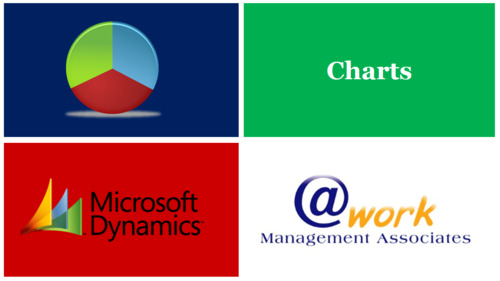
One of the purposes of using Microsoft Dynamics CRM is to make your reporting easier. To visualize the data from reports you might want to use charts. If you are familiar with the chart functionalities in Excel, Microsoft Dynamics CRM offers you even more options to create great charts!
Working with charts and analyzing charts for personal and business management purposes enriches your Microsoft Dynamics CRM user experience. Charts are available to provide you with online and real-time reporting. Microsoft Dynamics CRM allows you to create and view charts within the application. Microsoft Dynamics CRM 2011 & Online offers you several charts in the chart designer to choose from.
Microsoft Dynamics CRM charts are contextual, meaning that they will reflect the data from the current grid list of records. As you filter the data OR switch views, the chart you have chosen will automatically update appropriately. This is also called ‘context sensitive views’.
Although Microsoft Dynamics CRM comes with many charts, you can also (depending on your security role) easily create new charts to support your specific reporting needs. For more information and appropriate HTML coding please read [this] article.
To try yourself, login to Microsoft Dynamics CRM via your web browser and go to the ‘Sales’ area. Click on ‘Accounts’, the Account grid view appears. In the view selector, select ‘Active Accounts’ then on the ribbon, click the ‘Charts’ tab, and then click the ‘New Chart’ button.

The Chart Designer appears to the right of the grid. You can now customize your chart. When you are finished, press the ‘Save’ button followed by the ‘Close Designer’ button. Your chart is now available in the list of available charts.
A small exercise; you can also use Microsoft Dynamics CRM to drill down in a chart
Open the list of records that you want to view a chart. Then, click the chart bar on the right or top of the list of records. In the chart area, click the arrow next to the chart name, and then click a name of the chart that you want to see or for drilling down.
Click the category area of the chart in which you want to drill down further to see lower level data.
In the shortcut menu, click ‘Select Field’, and then click the field in which you want to group the category. For example, you are viewing a chart that shows opportunities by potential customers. You want to drill down to see the opportunities for one potential customer, grouped by probability. Click the potential customer on the chart, click ‘Select Field’, and then click ‘Probability’. The chart now shows the opportunities for this customer with the probability of each opportunity. Click the corresponding icon for a chart type that you want use for viewing the data. Click ‘OK’. You can drill down even further on the resulting chart from the drill down on a chart.
To help you get started making the most of using chart with Microsoft Dynamics CRM we recommend you to watch these 5 videos on charts and visualization:
Video 1 of 5 (Introduction)
Video 2 of 5 (Visualization overview)
Video 3 of 5 (Multiple series charts)
Video 4 of 5 (Multiple categories charts)
Video 5 of 5 (Stacked charts)
Happy tracking,
The @work CRM Team
2 notes
·
View notes
Text
Latest release for Spring 2015 of Microsoft Dynamics CRM and Microsoft Dynamics Marketing
We are proud to announce the latest general availability for spring 2015 worldwide of Dynamics CRM. It seems that this news get everyone exciting.
This update lights up new opportunity for all the CRM customers to enhance their business productivity with CRM. Microsoft continues to unlock more potential with solutions that work seamlessly together, improving tools that familiar to most of the preferred users and preferred sales professional’s user.
First release we would like to announce is the updated contextual customer information tools, as follows:
CRM App for Outlook
What it means for existing users & sales professionals? Your sales team is now able to create sales records directly from Outlook and to see relevant, contextual information such as sales activities, cases, and opportunities for the email sender and recipients.
Embedded OneNote
Other good news for the Sales professional. They can now create and view notes containing text, photos, voice, spreadsheets, and free – form drawings, all within Account, Opportunity, or any other record that currently been working on.
Analysis Function in Excel
Perform analysis in Excel directly within Microsoft Dynamics CRM. User can switch between applications during a task work outside CRM application.
Marketing
Microsoft Dynamics CRM Marketing is an integrated marketing management solution for marketing day to day operation starts from planning to execution across all preferred channels.
Marketing team is able to scale their multiple marketing activities across different channels with this application. It brings together sales and marketing for effective collaboration and better visibility in both activities that deliver competitive edge in business operation of a company.
The latest update for this particular segment is mainly around campaign and lead management. Here are few highlights:
Email Marketing & Lead Management
Create better quality leads list with double opt – in option and contact duplication feature in the Dynamics Marketing CRM. Furthermore, preferred marketing user can now use advance lead scoring modelling and analysis within the CRM environment. Together, marketers can create clean list and bring more relevancy into their marketing campaign.
Campaign Management
Improved segmentation feature using lead – based queries for marketing contacts. And they enable task sync (it’s customisable field in CRM)
Watch a video showcase about more awesome features of Microsoft Dynamics CRM Marketing such as Email Tracking, Office365 Groups, Document Management, Social Media Listening and other capabilities here.
1 note
·
View note
Text
Dynamics 365 - Unpacking a recent post
Dynamics 365 - Unpacking a recent post #msdyn365 #msdyncrm
As an experiment, back in February, I thought I would try using the LinkedIn “Create an Article” feature, to see how it compared to just posting to LinkedIn from my own blog. I can confidently report that the test was a huge failure. Anyone thinking of using LinkedIn’s “Create an Article” feature… don’t, it gets almost no traffic at all. But I did like the Article, and hardly anybody saw it, so I…
View On WordPress
0 notes
Video
youtube
Queue Associates explores how e-signing contracts in Microsoft Dynamics CRM can make your business more efficient and profitable. Check out the blog for reasons your organization should start using e-signatures in Microsoft Dynamics CRM.
http://www.queueassoc.com/reasons-esign-contracts-microsoft-dynamics-crm/
1 note
·
View note
Text
3 Ways to synchronize Microsoft Dynamics CRM Contacts to Outlook
The Synchronization of Microsoft Dynamics CRM (MSDCRM) contacts to Outlook is a feature that often doesn’t get the attention it deserves. This blog will highlight a number of options that can be used to ensure that you can easily manage which MSDCRM Contacts are synchronized to your Outlook.
The default setting in the Outlook Client for MSDCRM, synchronizes Active Contacts that you own in MSDCRM to Outlook. This means that if you create a Contact in MSDCRM or assign a Contact to yourself in MSDCRM this Contact will be synchronized to your Outlook. The disadvantage of the default setting is that a Contact can only have one “Owner” and that multiple Users within your organization may want to synchronize the same Contacts from MSDCRM.
To enable Users to stay in control of which MSDCRM Contacts are synchronized to their Outlook, the Outlook Filter for Contacts in MSDCRM can be configured to synchronize Contacts based on the following criteria:
1. Contacts you follow in MSDCRM
2. Contacts you follow in MSDCRM
3. Contacts you follow in MSDCRM
The benefits of these 3 options and the Outlook Filter settings required to achieve synchronization will be described in the following three chapters.
The Outlook Filter rules for Contacts can be adjusted (in Outlook 2013) by going to:
File > CRM > Synchronize > Outlook Filters
Here you can adjust the “My Outlook Contacts” filter:
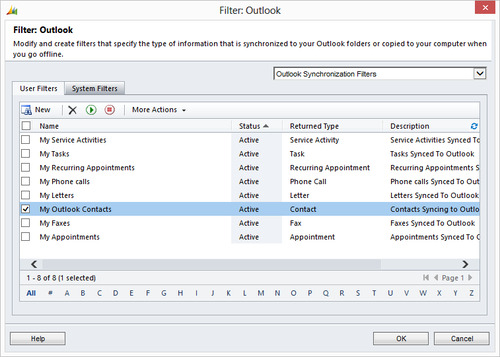
Contacts you follow in MSDCRM
The advantage of using the Follow functionality in MSDCRM to determine which Contacts are synchronized to Outlook is that multiple Users can follow one Contact and that it only takes one click to follow a Contact. You can follow contacts by selecting them and pressing the Follow button in the Ribbon.

The My Outlook Contacts filter needs to be configured as follows:

Contacts of Accounts you follow in MSDCRM
The main advantage of using the filter which synchronizes Contacts of Accounts you follow is that when colleagues add Contacts to an Account you follow these are also automatically synchronized to your Outlook. This way all the Contacts of the Accounts you are working on will automatically be synchronized to your Outlook.

Contacts you are Connected to in MSDCRM
The advantage of using Connections to determine which Contacts are synchronized to your Outlook is that the Connections can also be created by other Users and that Connections can offer additional value to your organization as they give an overview of who is Connected to the Contact and their Role.


I hope this blog article helps you effectively manage the MSDCRM Contacts that are synchronized to your Outlook. Feel free to contact us if you need help setting up your Outlook Filter(s).
Happy tracking,
the @work CRM Team
2 notes
·
View notes
Text
How CRM Solutions Work
Managed solutions
Managed solutions on the other hand can be edited and only removed by uninstalling/removing the solution, all the components and all the data. It’s all gone permanently; even if you then re-imported the managed solution all the data would be gone
Removing Components from your Solution
Removing a component from a solution will remove it from your solution but it is not deleted and will still exist in the Default Solution. You remove a component; you select the component whilst inside your solution and then press the Remove button. This will remove the component reference from your solution but not delete/remove it from the default solution.
Don’t get Remove mixed up with Delete. Pressing the Delete button will delete the component. Important System entities cannot be deleted from the system (Case, Account etc), custom components can be deleted.
Dependent Components
When you try and delete a component that has a dependency, it will pop up a dependent component dialog that informs you there is a dependency and stops you deleting the component
If you try to delete a component which has dependencies then you will need to delete the components which depend on the component you are trying to delete. You may have to remove multiple dependencies.
Required Components
You can see the required components for a component by selecting the component and clicking show dependencies. This will show dependent components and required components.
Required components will not prevent you deleting the component. They are often things like Webresources with JavaScript, plugin, a view. You don’t need these things in your solutions every time but you will need these components to have been imported into the target system at some point.
If you are missing a required component you will get the Missing Required Components Dialog When Adding Components to a Solution. This won’t stop you exporting the solution.
What can be Added to a Solution?
The following is a list of solution components that you can view within a solution:
Application Ribbon
Article Template
Business Rule
Chart
Connection Role
Contract Template
Dashboard
Email Template
Entity
Entity Relationship
Field
Field Security Profile
Form
Mail Merge Template
Message
Option Set
Plug-in Assembly
Process
Report
Sdk Message Processing Step
Security Role
Service Endpoint
Site Map
Web Resource
What cannot be added?
Business Units
Teams
Queues
Goals
Subjects
Product Catalog
The items above must be either created manually or imported. If you want to create manual data and use the same guide between systems then you will need to export and import the data so you can specify the guide used. One good example of CRM integration between Microsoft Dynamics CRM / CRM Online and Exchange Server/Outlook can be seen here.
How Solutions are applied
All solutions are evaluated as layers to determine what your CRM application will actually do. The following diagram shows how managed and unmanaged solutions are evaluated and how changes in them will appear in your organization.

0 notes
Text
Dynamics 365 - The Transition to Unified Interface
Dynamics 365 - The Transition to Unified Interface #HangTen #msdyn365 #msdyncrm
There is no need to panic…yet. Procrastinators can freely ignore this post, for now. But if you are one of those people who hates scrambling at the last minute, then maybe this will interest you.
(more…)
View On WordPress
0 notes
Video
youtube
Discover Microsoft Dynamics CRM and find out how it can impact your sales, customer service and marketing. Microsoft Dynamics CRM (customer relationship management) allows you to combine familiar Microsoft® Office applications with powerful CRM software to improve marketing effectiveness, boost sales, and enrich customer service interactions. http://www.queueassoc.com/solution/microsoft-dynamics-crm/
1 note
·
View note
Text
CRM summer school: Importing Data in Microsoft Dynamics CRM 2011
When your Microsoft Dynamics CRM system is installed, the next step is to configure and then add data. Without the data the system cannot share and analyze valuable customer information. Therefore it is important to move your existing (accurate) data into the system. This can be done by manually entering the data but, that is very time consuming and multiple typing errors could occur. The easier and more efficient way is to import data step by step and with the help of functionalities that are already available for you in Microsoft Dynamics CRM.
There are six important steps you need to take to ensure the right data will get into the right place in your Microsoft Dynamics CRM system:

1. Organize your source data
2. Determine for which fields data duplication is required
3. Use templates
4. Map your source data
5. Import your data
6. Verify the data
These options are also important if you already have data in your system, but want to (for example) add a list of contacts or leads you recently acquired.
Organize your source data
Organizing your source data is important to make sure that each type of data is in its own column. In the below topic ‘CRM Templates’ we explain how to organize your source data by using CRM templates. Of course there are countless other options, which you can read about in the Microsoft Help topic Work with Imports.
Determine data duplication rules
To avoid the import of duplicate records, it is essential to define duplicate detection settings in your Microsoft Dynamics CRM system. It is possible to select multiple attributes at the same time (e.g. Account name and address fields). Also, more than one duplicate detection setting per entity is possible (e.g. an additional setting for Account’s website URL).
CRM Templates
In Microsoft Dynamics CRM, you can generate templates that will help you with the preparation of your data. These import templates are in an XML format which you can open with Excel. To create such a template you need to go to the Data Import button in your ribbon, and select Download Template for Import in the dropdown list. This will open a window with a dropdown where you can select an entity from. Once you have made your selection, click on the download button to download the template.

Once this is downloaded you first need to unblock the file to prevent an error from appearing.

To unblock the file, right click on the XML file and open the properties. Here you will see a button to unblock the file.
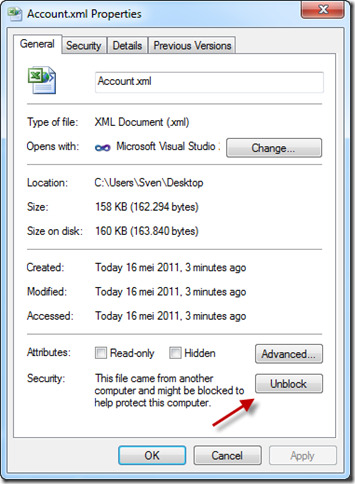
You can open the Excel template, which would look like this:

You can put all the data you wish to import in this Excel sheet and off you go importing it!
Map your source data
It is important to determine where each column in your data belongs in your Microsoft Dynamics CRM system. Mapping the data from your source file to Microsoft Dynamics CRM can be done automatically or by using a data map that explicitly maps your source columns to Microsoft Dynamics CRM fields. The following table shows when to use auto mapping or when to use a data map.
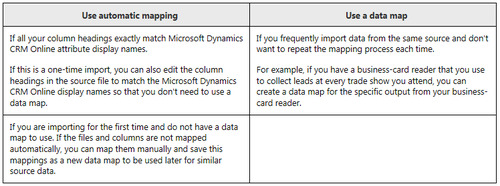
If you are going to use automatic mapping you need to edit the column headers in your source data to exactly match the display labels in Microsoft Dynamics CRM. If you are going to use a data map, you can use an existing one or you can create a new Data Map in Microsoft Dynamics CRM.
Import your data
There are multiple instructions on how to import data via the wizard and if you click [here] you will go to the very helpful Microsoft Customer Center page and find a lot of useful articles and videos that will guide you through the process.
Verify the data
Overall, it is important to keep verifying Microsoft Dynamics CRM records versus the data source information. If errors occur, try to find out the reason of the error and then there are two possibilities to continue:
1. Remove all imported records (bulk delete) and start over;
2. Export errors, fix problems and import again with same data mapping.
Data importing is one of the reasons you want to work with a certified Microsoft Dynamics CRM partner like @work www.atworkmgt.nl . It takes experience to do it right.
Happy Tracking!
The @work team
(source: Microsoft Customer Center)
2 notes
·
View notes
Text
I am Fred's Bow Tie - Part 3 (the Finale!)
Cliffhangers are the worst! Sorry to keep you hanging. Here’s what happened:
No, I did not get onstage, nor backstage.
But I faked it here:

And got this sweet pic with security:

And as it turns out, there were a TON of people who looked just like me at the show (hipster nerds!):



No comment on this last pic. I just had to include it... just because.
In all seriousness, seeing the band Fun. was the perfect way to end a week-long conference of meetings, sessions, vision-setting, demos, customer meetings, hands-on labs, and general carousing. Fun!
Back in IAFBT – Part 1 we talked about goals and metrics. I had a personal goal with FBT to “gain more followers”… Which developed into “drive fun and excitement yet provide value to conference-goers”... But those are words, not numbers. I saw my Twitter followers increase from about 150 at the start of the conference to over 400 by the end. Not too bad. And thankfully, we have a whole social media team who was able to articulate goals and numbers in a much more quantified way. Thanks Kelly Rigotti and the Social Media team!
Fred’s Bow Tie Results for Convergence March 3-7, 2014:
322 tweets sent
178 favorites
108 replies
312 retweets
500,956 reach
478 @FredsBowTie mentions!
I may not be great with numbers but I am super competitive, so I took these numbers and compared them to the rest of the Convergence social metrics and found some positive and not so positive results. For example, my number of retweets was 23% of the conference’s overall retweets (with hashtag #conv14). But my reach overall was only 1% of the overall conference reach. Meh.
With social media, the path to success is to get your content shared across a lot of people that gets them to DO something. Expose -> Influence -> Engage -> Action/Convert. So without the reach, the influence and some sort of conversion measurement, who cares?
Was this an enormous waste of time?
Maybe, maybe not. My goals were: have fun, drive excitement, and provide value to conference-goers. I believe I did that according to my favorites and retweets. But it was an incomplete goal without the So What. So what kind of business impact did I drive? Is that every fully known? Should I have sprinkled in calls to action in my tweets? Should I have had some links on hand to drive folks to more content, downloads, webcast invites? Maybe, but then it may have taken away some of the authenticity and spontaneity.
But not all hope is lost. Let’s get back to the “provide value” part and see if we can do anything there.
First, I’m looking at business value in context of the technology. Here are some examples:
CRM “Leo” release in Spring Wave ’14 is for Online AND On-Premise customers – 15 retweets, 3 favorites.

Options to avoid autosave in CRM 2013 – 9 retweets.
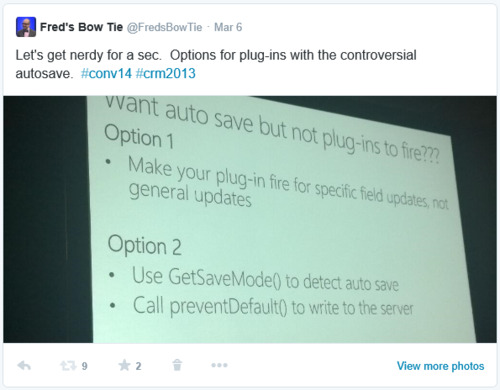
Form Diagnostics shortcut – 5 retweets.
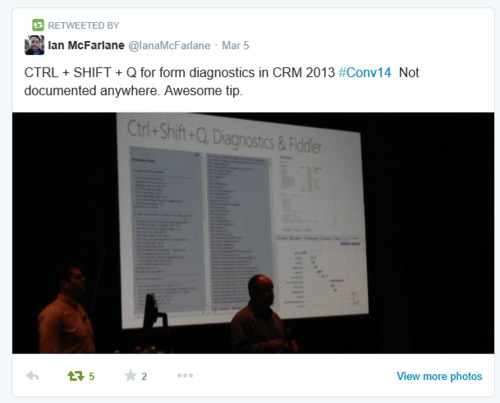
And so on.
But then there’s value in making the audience feel special. Examples:
Attendee Love – 10 retweets.

Customer Success at Delta – 11 retweets.

Shout out to Umberto Milletti at Insideview for their great partnership – 7 retweets.
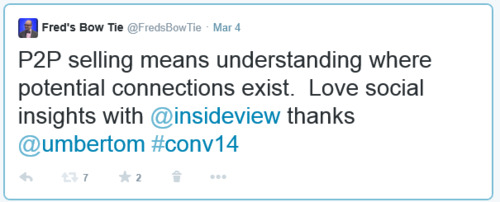
Based on the content shared in highly retweeted posts we can derive “So What” value and drive specific follow-up actions. We can take follow-up actions as a business to ensure that our existing customers, partners, and prospective customers understand that the Spring Wave ’14 release for core CRM functionality will apply as an on-premise update (this wasn’t the case in early communications). We can look at providing more tips-and-tricks type content via blog posts and webcasts to power users around diagnostics and autosave options. We can continue to build and share great customer and partner stories.
And we can always, always find ways to make our audience feel special by complimenting their successes and thanking them for being with us.
Because with amazing customer experiences, it comes down to this:
People will forget what you said People will forget what you did But people will never forget how you made them feel.
-Maya Angelou
And in leveraging social media to drive business value, perhaps connecting with people emotionally is the most important thing.
Fred's Bow Tie, out!

0 notes
Text
Dynamics 365 - The New RapidStart is Here!
Dynamics 365 - The New RapidStart is Here! #msdyn365 #msdyncrm #mspartner
Those of you who follow me, know that we have a product called RapidStart for Dynamics 365. Well, not “we” actually, RapidStart LLC is a separate company owned by my wife. So I guess I should say, “she” has a product called RapidStart for Dynamics 365. Anyway, that product has just been “re-imagined”.
(more…)
View On WordPress
0 notes